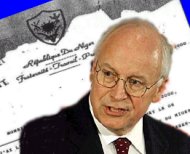Tuesday, October 28, 2003

Josh Marshall, excerpted in this space within Saturday’s Grover's Radical Roundup, continues to impress with his dogged interest in how the famous yellowcake documents came into being.
I’ve been reading Mr. Marshall for over a year now and I’ve found his site highly interesting.
He does seem to have, from his coffee shop perch in Dupont Circle, some fairly good Washington sources.
This morning he briefly tantalizes with a description of the famous meeting between the Vice President and CIA briefers that resulted in Ambassador’s Wilson’s trip to Niger.
Josh flatly says:
The briefer didn’t bring it up. Cheney did…if Cheney didn’t hear about it from one of his intel briefings, where’d he hear about it? Specifically. Who put Cheney on to the Niger uranium story?
Marshall quotes from a portion Sy Hersh’s current Stovepipe story in The New Yorker that mentions an Italian businessman and security consultant as the person who first mentioned the Niger documents to an Italian journalist in early October of 2002.
Josh quite correctly wonders who this mysterious gentlemen is and how he fits into a puzzle purposely burdened with an over abundance of meaningless detail.
An impatient reader might wish to frustrate themselves with a Google of cheney and niger where one can peruse 28,800 hits or bush and niger for a paltry 254,000 relevant hits.
An excellent timeline of known information related to the yellowcake allegation can be less frustratingly accessed here at the Center for Cooperative Research.
On July 6 of this year, in a New York Times op-ed, Ambassador Wilson suggested that the Vice President’s office asked for the Niger information that prompted his CIA sponsored mission.
The White House denied this on July 11 but Robert Novak in his “plame”ous July 14th column said:
The White House, State Department and Pentagon, and not just Vice President Dick Cheney, asked the CIA to look into it [yellowcake from Niger].
Hersh, in the October 20 Stovepipe article, said:
“The Vice-President saw a piece of intelligence reporting that Niger was attempting to buy uranium,” Cathie Martin, the spokeswoman for Cheney, told me. Sometime after he first saw it, Cheney brought it up at his regularly scheduled daily briefing from the C.I.A.
On April 16 I posted some material related to the looting of the Iraq museum from a blog published by Brian Pfaffenberger of the University of Virginia:
A group of art traders, calling itself the American Council for Cultural Policy (ACCP), recently met with Defense Department officials…According to German antiquities expert named Sonja Zekri, the ACCP's goal is to " loosen up the Iraqi antiquities laws" under an American-controlled postwar regime.
According to an April 6 report in Scotland’s Sunday Herald, the ACCP has among its main members…collectors and lawyers with chequered histories in collecting valuable artifacts, including alleged exhibitions of Nazi loot.
If I were a betting man I’d bet that the businessmen of the ACCP could have made use of a well-connected Italian businessman and security consultant.
Just who are the members of the American Council for Cultural Policy?
From the State Department’s Bureau of Educational and Cultural Affairs and Interpol, photographs of the 30 most valuable items still missing from the Iraq National Museum and, unlike the still missing WMD and various missing or unidentified principals, likely resting on certain well-connected coffee tables.
Images: Getty and Information Clearing House

